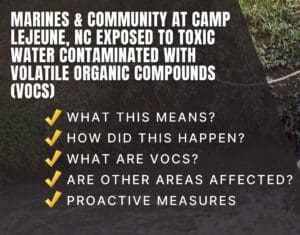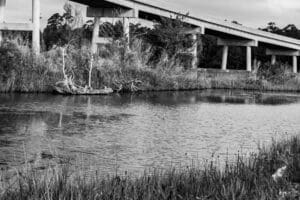How the Camp Lejeune Lawsuit Started
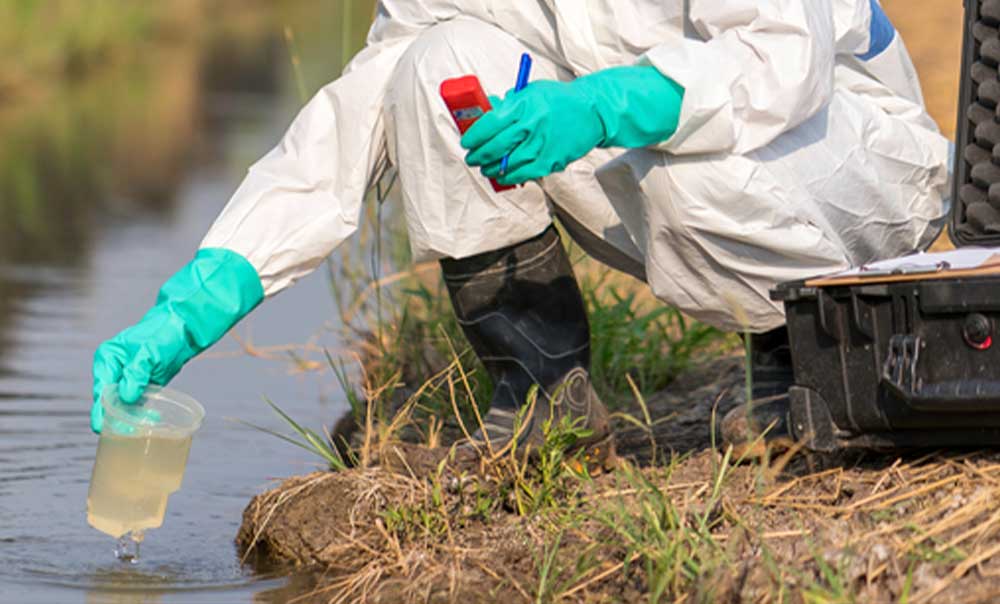
In the early 1940s, the U.S. government approved the construction of the Camp Lejeune Marine Corps base in Jacksonville, North Carolina. For years, it housed soldiers training for duty, as well as their families. Nearby water sources provided all the water they needed for drinking, bathing, cooking, and cleaning.
Eventually, it was revealed that the base’s water supply had become a significant source of exposure to deadly toxins. For over 34 years, the water supply at Camp Lejeune was contaminated with dangerous chemicals, as officials of the base insisted there was no issue with the water supply and refused to shut it off.
It is estimated that between 750,000 and a million military personnel and their family members, as well as civilian workers, were exposed to these harmful chemicals. The full effects of this scandal are still not fully understood, as many victims had their cases delayed or dismissed. However, we know that thousands of inhabitants of Camp Lejeune have suffered serious illnesses, including cancers, birth defects, and other conditions, as a result of exposure.
What Was in the Water at Camp Lejeune?
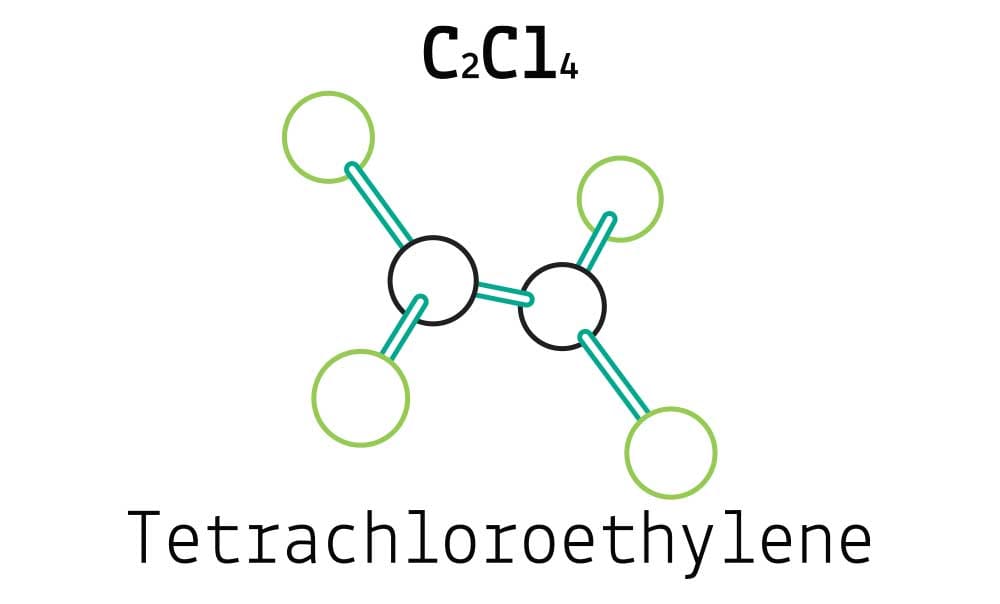
In 1980, in accordance with new Environment Protection Agency (EPA) regulations brought about by the Safe Drinking Water Act of 1974, the U.S. Marine Corps began testing the water supplies throughout the Camp Lejeune base for contaminants.
Testing was first done by the U.S. Army Environmental Hygiene Agency and was completed in March 1981. The most harmful chemicals were identified primarily as tetrachloroethylene, also known as perchloroethylene (PCE), trichloroethylene (TCE), benzene, and vinyl chloride.
Micro amounts of these chemicals are not harmful. However, unusually high amounts of drinking, cooking, cleaning, or bathing water are carcinogenic and very harmful to the person directly exposed to and/or the health of infants born to women exposed to while pregnant. The chemicals can be absorbed into the body by ingesting the water by drinking or consuming food cooked in the contaminated water, absorbed through the skin, or inhaled into the lungs.
Who Is Responsible for the Water Contamination at Camp Lejeune?
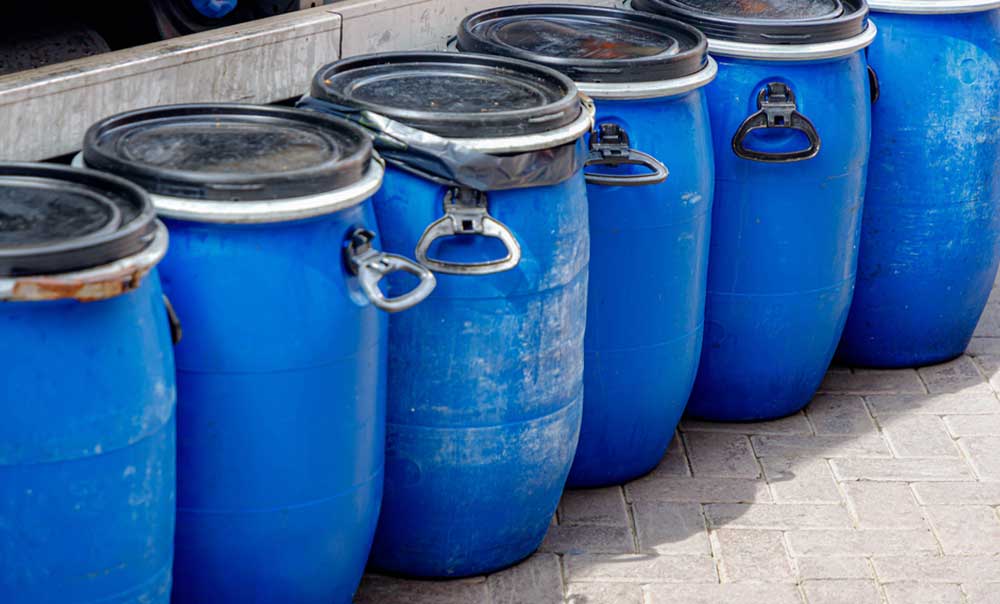
The main source for PCE was an off-base dry cleaning company called ABC One-Hour Cleaners, owned by Victor and Martha Melts, who settled with the Environmental Protection Agency (EPA) in 2000 for $270,000. For at least 30 years, the dry cleaning company dumped dry cleaning solvents into the ground. Eventually, those solvents leaked into a nearby water well-supplying water at Camp Lejeune. Another source of chemical contamination came from TCE solvents used to clean military weapons and machinery on the base.
The levels of PCE and TCE were found to be exponentially higher than the EPA’s maximum safe levels.
As reports of heavily contaminated water emerged, testing agents advised base officials that the water supply wells were poisoned with toxic chemicals and needed to be shut down immediately. However, USMC officials fraudulently reported back to the EPA that there were no contamination issues at Camp Lejeune. No action was taken to shut down the water wells. It wasn’t until 1984 after additional testing was conducted and reported, that they began shutting down the affected water wells.
Health Risks Linked to Camp Lejeune Water
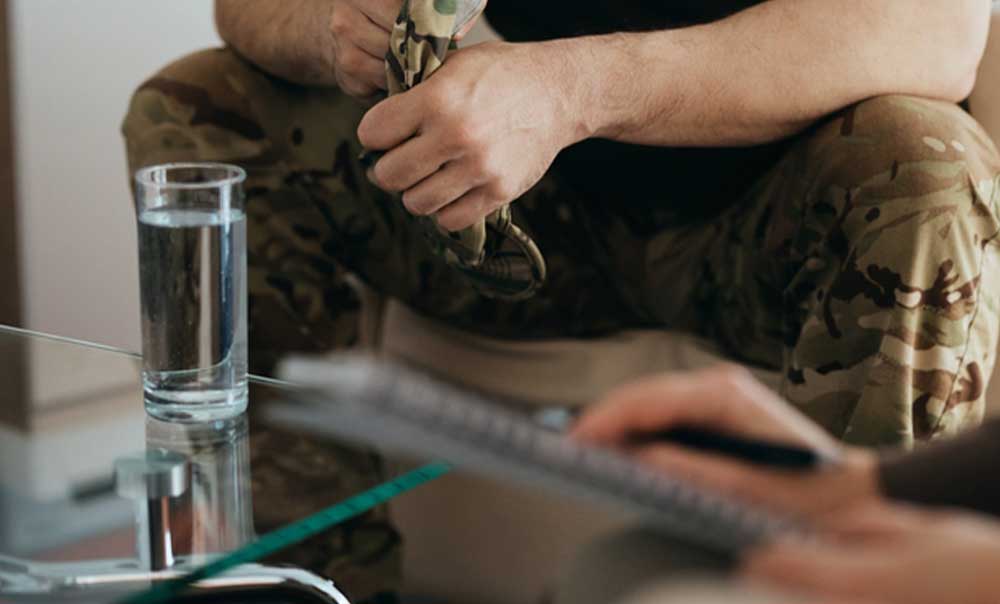
The chemicals discovered by the EPA to have contaminated the water at Camp Lejeune have been identified as carcinogenic (cancer-causing) and are linked to other diseases, illnesses, and health conditions. Thanks to decades worth of study and research by the Agency for Toxic Substances and Disease Registry (ATSDR), there is a long list of cancers, diseases, illnesses, and health conditions directly related to exposure to the chemicals found in the contaminated water at Camp Lejeune.
Under the Camp Lejeune Justice Act of 2022 (CLJA), the list of cancers, diseases, and other illnesses and injuries related to exposure has been greatly expanded:
- Aplastic anemia
- Babies being small for gestational age
- Bladder cancer
- Brain cancer
- Breast cancer
- Cardiac defects
- Cervical cancer
- End-stage renal disease
- Esophageal cancer
- Eye defects
- Fetal death
- Hepatic steatosis
- Hodgkin lymphoma
- Impaired immune system function
- Infertility
- Kidney cancer
- Leukemia
- Liver cancer
- Liver cirrhosis
- Low birth weight
- Lung cancer
- Major malformations
- Miscarriage
- Mood effects (anxiety or depression)
- Multiple myeloma
- Nasal passages blocked with bone tissue
- Neural tube defects
- Neurobehavioral effects (performance deficits such as delayed recall or ALS)
- Neurological effects (memory loss, attention or color blindness)
- Non-Hodgkin’s lymphoma
- Oral cleft defects
- Ovarian cancer
- Parkinson’s disease
- Prostate cancer
- Rectal cancer
- Renal toxicity
- Scleroderma
- Skin disorders
- Soft tissue cancer
Symptoms to Watch For
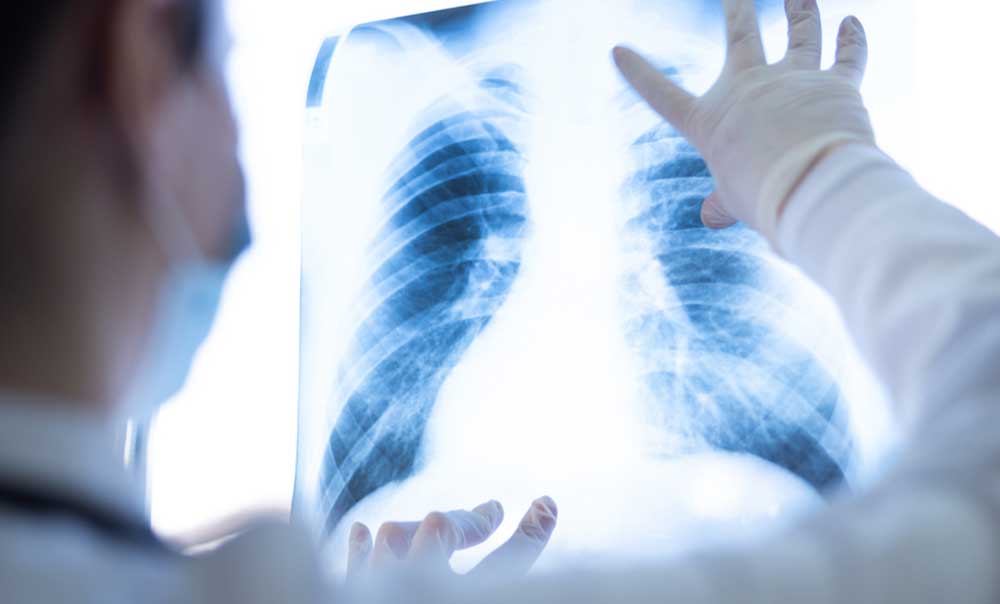
If you or someone you love were exposed to the contaminated water at Camp Lejeune and have not yet been diagnosed with cancer or another condition, it is still recommended to screen for any signs of illness. The sooner you’re diagnosed, the sooner you can receive treatment. Here are some symptoms to watch out for in some of the more common ailments associated with exposure.
Bladder Cancer
Bladder cancer is a common type of cancer that usually forms in the cells lining the bladder, the tubes that carry urine from the kidneys to the bladder (known as the ureter), or the tubes that lead urine out of the body (urethra). Military personnel, their families, and civilian employees exposed to both PCE and TCE have an increased risk of developing bladder cancer. Symptoms of bladder cancer include back pain, difficult or painful urination, frequent urination, and very dark or bloody urine.
Breast Cancer
One of the most common types of cancers linked to Camp Lejeune water contamination is breast cancer. There are a number of symptoms that women should be aware of when it comes to breast cancer. These include a change in the size or shape of the breasts, a change in the texture of the skin on the breasts; dry, flaky, red, or thickened skin on the breast; nipple retraction or turning inward; pain in the breast or nipple, skin dimpling (resembling an orange peel in some cases), a lump in the breast, swelling (in all or part of the breast), even if no lump is felt, swollen lymph nodes near the collarbone or under the arm, and discharge from the nipple. If you experience any of these symptoms, it is important to see a doctor right away.
Cervical Cancer
Cervical cancer develops in the tissues of the cervix, the lower part of the uterus. Cervical cancer is caused by a virus known as human papillomavirus (HPV). Researchers believe that the contaminated water at Camp Lejeune may have increased the risk of cervical cancer by exposing women to HPV. There are a number of symptoms associated with cervical cancer. These include bleeding between periods, bleeding after sexual intercourse, and pain during sexual intercourse.
Esophageal Cancer
Esophageal cancer is relatively rare, accounting for only about 1% of all cancers diagnosed in the United States each year. However, it is one of the deadliest types of cancer, with a five-year survival rate of only about 20%. This is because esophageal cancer often goes undetected until it has spread to other parts of the body. Symptoms of esophageal cancer include difficulty swallowing, weight loss, and pain in the throat or back. Contaminated water at Camp Lejeune may have increased the risk of esophageal cancer by damaging the DNA of the cells in the esophagus.
Kidney Cancer
Kidney cancer begins in the cells of the kidney and can spread to other parts of the body. Contaminated water has been linked to an increased risk of kidney cancer due to exposure to chemicals like benzene and trichloroethylene (TCE). The risk is highest among people who were exposed to the water for longer periods of time. Symptoms of kidney cancer include blood in the urine, a lump and/or pain in the side or lower back, a mass in the abdomen, exhaustion or fatigue, loss of appetite, anemia (low red blood count), persistent fever, and unintended weight loss. If you experience any of these symptoms, it is important to see a doctor right away.
Liver Cancer
The ATSDR found that men who were exposed to the contaminated water at Camp Lejeune were twice as likely to develop liver cancer as those who had not been exposed. It is believed that the contaminated water may have increased the risk of liver cancer by exposing people to chemicals like benzene and trichloroethylene (TCE). These chemicals can damage DNA and lead to the development of cancer. There are a number of symptoms associated with liver cancer. These include abdominal swelling, fatigue, loss of appetite, muscle weakness, nausea and vomiting, pain in the upper abdomen, unintended weight loss, white, chalky bowel movements, and yellow discoloration of the eyes and skin (jaundice).
Non-Hodgkin’s Lymphoma
The risk of developing non-Hodgkin’s lymphoma was found to be two times greater for those who drank the contaminated water at Camp Lejeune. This is cancer that begins in the cells of the lymph system, part of the immune system. The symptoms of non-Hodgkin’s lymphoma can include abdominal pain or swelling, chest pain, coughing, swollen lymph nodes in the armpits, groin, or neck, fatigue, fever, night sweats, trouble breathing and unintended weight loss. Contaminated water at Camp Lejeune has the elements to create a toxic environment in the body and suppress the immune system. It is important to see a doctor if you experience any of these symptoms. Early detection is important for the successful treatment of this type of cancer.
Lung Cancer
Lung cancer is one of the deadliest types of cancer and can be difficult to catch in its early stages. The risk of lung cancer increases with exposure to certain chemicals, including benzene. The most common symptom of lung cancer is a cough that does not go away. Other symptoms include chest pain, shortness of breath, wheezing, and loss of appetite. These symptoms can also be caused by other conditions, so it is important to see your doctor if you are experiencing any of them. Lung cancer is treated with surgery, chemotherapy, and radiation therapy. The type of treatment depends on the stage of cancer and the individual patient.
Prostate Cancer
Prostate cancer is one of the most common types of cancer. In its early stages, prostate cancer may not cause any noticeable symptoms. Symptoms of advanced prostate cancer include blood in the semen and/or urine, bone pain, erectile dysfunction, less forceful urine stream, trouble urinating, and unintended weight loss.
Multiple Myeloma
The occurrence of this cancer is increased by 56% for those exposed to Camp Lejeune water contamination. This cancer attacks plasma cells in the bone marrow and causes problems with the production of blood cells. Multiple myeloma is hard to diagnose in its early stages because it shares symptoms with other illnesses. These can include fatigue, bone pain or fractures, especially in the chest or spine, frequent infections, nausea, anemia, confusion, constipation, excessive thirst, loss of appetite, numbness or weakness in the legs and unintended weight loss. The exact cause of multiple myeloma is unknown, but it is thought to be caused by a combination of environmental and genetic factors.
Infertility In Women
An increased risk of infertility in women has also been linked to Camp Lejeune’s contaminated water. Infertility is defined as the inability to conceive after one year of unprotected sex. There are many factors that can contribute to infertility, and it is often a complex condition with no clear cause. However, exposure to certain chemicals has been linked to an increased risk of infertility in women, and it is thought that the Camp Lejeune water contamination may have played a role. If you believe you were exposed to contaminated water at Camp Lejeune, it is critical that you speak with your doctor about your fertility options.
Adult Leukemia
Adult leukemia is the abnormal growth of blood cells in the bone marrow. This abnormal growth of blood cells can crowd out healthy blood cells and lead to serious health problems. People who were exposed to the contaminated water at Camp Lejeune were found to be more likely to develop adult leukemia. The symptoms of adult leukemia can include bleeding gums, bone or joint pain, fatigue, fever or night sweats, frequent infections, nosebleeds, pale skin, purplish or darkened patches of skin, rash or tiny red spots on the skin (petechiae), shortness of breath, swollen lymph nodes in the groin, neck, stomach, or underarm areas, unexplained weight loss, and easy bruising or bleeding. Most people with adult leukemia will need treatment with chemotherapy or radiation. The water at Camp Lejeune was contaminated with benzene, a known carcinogen that has been linked to leukemia. If you were exposed to contaminated water, it is important to talk to your doctor about your risk for leukemia.
Aplastic Anemia
The chemicals in the water at Camp Lejeune have been linked to aplastic anemia, which is a condition in which the body does not produce enough new blood cells. Risk factors that have been linked to aplastic anemia include exposure to chemicals like benzene and trichloroethylene (TCE). Symptoms of aplastic anemia can include fatigue, shortness of breath, and easy bruising or bleeding. The treatment for aplastic anemia is a bone marrow transplant. The symptoms can be mild or severe, and they can come on suddenly or gradually. In a research study of people who were exposed to the contaminated water at Camp Lejeune, the risk for aplastic anemia was found to be increased.
Renal Toxicity
Another symptom that is common in individuals who have been exposed to contaminated water at Camp Lejeune is renal toxicity. Renal toxicity is damage to the kidneys that can lead to kidney failure. Some of the symptoms associated with renal toxicity include changes in urination, frequent urination, blood in the urine, swelling in the feet, ankles, or legs, nausea and weakness. This condition can be very serious and if you believe that you may have been exposed to contaminated water at Camp Lejeune, it is important to seek medical attention as soon as possible.
Scleroderma
Scleroderma (or systemic sclerosis) is a potentially fatal autoimmune disease that involves the hardening, inflammation, or thickening of the skin. It can also affect the tissues and organs inside the body, including the lungs, heart, and kidneys. The symptoms of scleroderma vary depending on the organs affected. Skin symptoms may include hard, thickening, or tight skin, dry, itchy skin, burning or swelling, less sweating, muscle weakness, salt-and-pepper-like patches of skin on the back, chest, or scalp, skin color changes, hair loss, sores or ulcers on fingertips, visible blood vessels, stiff joints, difficulty moving, and reduced blood flow to the extremities. When scleroderma affects the internal organs, it can cause shortness of breath, heartburn, swelling in the arms and legs, fatigue, and numbness or tingling in the fingers and toes. There is no cure for scleroderma, but treatments are available to help manage the symptoms. Although the precise cause of scleroderma is still unknown, it is thought to be linked to an overactive immune system and contaminated water.
Hepatic Steatosis
One of the most common symptoms associated with Camp Lejeune water contamination is hepatic steatosis, more commonly known as fatty liver disease. This condition occurs when there is an accumulation of fat in the liver cells. Symptoms of hepatic steatosis can include fatigue, weight loss, and pain in the upper right abdomen. In some cases, fatty liver disease can lead to more serious conditions, such as cirrhosis of the liver or liver cancer. The treatment for hepatic steatosis generally involves lifestyle changes, such as diet and exercise. In some cases, medication may be necessary to control the symptoms.
Neurobehavioral Effects
Neurobehavioral effects refer to how changes to the nervous system, particularly the brain, can affect our emotion, behavior, and learning. Consuming the toxic water at Camp Lejeune could have negatively impacted someone’s nervous system and caused many different changes to their physical abilities and mental state as a result. Neurobehavioral effects may include aggression, anxiety, attention difficulties or trouble concentrating, confusion, dementia, depression, difficulty sleeping or insomnia, dizziness, fatigue, headaches, lack of coordination, learning disorders, memory issues, poor motor skills, post-traumatic stress disorder (PTSD), tension, tremors or involuntary movements and weakness. Neurobehavioral effects have been reported in children exposed to volatile organic chemicals (VOCs) in drinking water. These effects include problems with attention, learning, and social interactions as well as aggressive behavior. Contaminated water at Camp Lejeune was also linked to an increased risk of Parkinson’s disease, amyotrophic lateral sclerosis (ALS), and other neurological diseases. Researchers are still working to understand all of the potential health effects of exposure to VOCs. These neurobehavioral effects are of particular concern because they can last a lifetime.
Who Can File a Camp Lejeune Water Contamination Lawsuit?

There have been many claims and lawsuits filed by water contamination victims since the Camp Lejeune scandal was uncovered. Some have received benefits from veteran affairs. However, many were denied benefits or compensation and their cases were delayed long enough that they were dismissed, reached a statute of limitation, or the claimant died. Others attempted to file claims or lawsuits too late because of statute of limitations and were denied or dismissed. The Camp Lejeune Justice Act of 2022 changes all of that.
Under the newly passed Camp Lejeune Justice Act of 2022, the federal government has allotted $6.7 billion to compensate victims of the water contamination. Even if you were one of the hundreds of victims that have previously filed a claim that was dismissed due to statute of limitations or if you have or are currently receiving disability benefits, you can still file a lawsuit.
If you or a loved one or someone you know was stationed, worked at or visited Camp Lejeune for at least a 30-day period (continuous or non-continuous) between August 1, 1953 and December 31, 1987 and developed cancer or disease or miscarried or suffered a birth defect or abnormality, even if that person has already passed away, you may qualify for compensation.
What is the Camp Lejeune Justice Act of 2022?

According to the official summary of H.R.2192, originally introduced in the House of Representatives on March 26, 2021, as the Camp Lejeune Justice Act of 2021, “This bill allows certain individuals to sue and recover damages for harm from exposure to contaminated water at Camp Lejeune in North Carolina between August 1, 1953, and December 31, 1987. This action is available only to individuals who were exposed to contaminated water for at least 30 days. The bill prohibits the U.S. government from asserting specified immunity from litigation in response to such a lawsuit. The bill also prohibits an individual who brings such an action from bringing a separate tort action against the United States based on the same harm.”
The Camp Lejeune Justice Act is part of a larger bill called the Honoring our Promise to Address Comprehensive Toxics Act of 2022 or the Honoring our PACT Act of 2022 (PACT Act). H.R.3967, as it is formally known and presented before the House and Senate, summarizes that “This bill addresses health care, presumption of service-connection, research, resources, and other matters related to veterans who were exposed to toxic substances during military service.”
Generally, the larger PACT Act provides help and assistance to approximately 3.5 million veterans exposed to hazardous toxins during their military service to the United States, such as while working burn pits in Iran, Afghanistan and elsewhere to dispose of environmentally hazardous materials and other waste. The PACT Act provides greater ease for veterans to receive benefits and expands treatment options.
The Camp Lejeune Justice Act, under this larger umbrella PACT Act, specifically addresses the exposure to water contamination of veterans, their families, civil workers and other personnel and visitors. On August 2, 2022, the Senate voted 86-11 approve the PACT Act. On August 10, 2022, President Joe Biden signed this bill into law.
Under the CLJA, water contamination exposure victims can now bring forth claims and lawsuits to receive benefits and compensation that were previously denied or dismissed due to limited allowed health conditions, over-burden of proof or statute of limitations.
Camp Lejeune Lawsuit Progress So Far

Although it is believed that up to one million military personnel and their family members were affected by the contaminated water at Camp Lejeune, most victims have seen no compensation or benefits from the U.S. government. Many lawsuits were dismissed or delayed past the statute of limitations, preventing victims from claiming damages for their suffering.
The passage of the Camp Lejeune Justice Act of 2022 changes that, allowing those affected to file suit, even if they previously filed a lawsuit or received benefits from Veterans Affairs. While there have been no lawsuit decisions as of yet, that will begin to change soon as veterans and their families come forward to finally claim what they are owed.
Before being able to file a lawsuit, all plaintiffs must go through a 6 month administrative claim process. The claim must be denied, or the 6 month time must elapse before a lawsuit can ensue. It is anticipated that many claims will be settled during this administrative claim process before a civil lawsuit can be brought forth.
There is not an equal amount that will be divided amongst all of the complainants. Compensation will be determined on a case-by-case basis and will depend largely upon the type of injury incurred by the water contamination. Those who died or are still suffering with cancer will likely be compensated the most. It is critical that you connect with the most qualified legal care to ensure you receive what you are owed.
Factors That Can Affect Camp Lejeune Lawsuit Settlement Amounts

No two lawsuits are ever the same. Many factors can influence the outcome of a case, so getting exact figures for your losses can be challenging. However, some factors are more common than others. While each Camp Lejeune water contamination case is unique, the following factors may affect the settlement amount.
- Previous, ongoing, and future medical costs
Plaintiffs exposed to contaminated water at Camp Lejeune may be eligible to recover the costs of past, present, and even expected future medical bills related to their medical condition. In addition, severe and long-term physical, mental, and emotional suffering often translate to higher hospitalization costs. A lawsuit that involves these kinds of suffering will undoubtedly take more time and cost more.
- Lost income
Suffering from disease, illness, or other conditions after exposure to contaminated water can render a plaintiff unable to work for a long time after their diagnosis. Even if they managed to fully recover and overcome their condition, there is a chance that they may not be able to work in the same capacity again, or worse, become unable to do anything at all because their condition left them completely disabled.
- Pain and suffering damages
As far as Camp Lejeune lawsuits are concerned, damages are not only physical and financial. While not quantifiable in bills and receipts, mental and emotional suffering can be just as painful and stressful. And since there is no way to determine how much a person’s pain and suffering cost, these kinds of damages will significantly vary for each plaintiff.
- Loss of joy of living
Suppose a person’s condition as a result of exposure to contaminated water at Camp Lejeune left them permanently disabled and unable to enjoy life the way they did before they became ill. In that case, they can pursue damages to compensate for their condition’s impact on their life. While no amount could ever make up for a life-long disability, the justice system can work to provide some monetary respite.
Why Camp Lejeune Lawsuit Settlements Can Be Ideal
Settlements may not always be the best course of action for every Camp Lejeune water contamination lawsuit, but there are a few reasons why they can be more beneficial than trials.
- Guaranteed payout
Compensation is guaranteed once both the plaintiffs and the defendant agree on the terms.
- Avoiding the additional financial burden
Lawsuits and other related legal proceedings are costly for both parties, especially for the plaintiffs. Not all Camp Lejeune complainants are financially capable of pursuing litigation in court. A settlement helps avoid this obstacle.
- Saves time
It can take a while before a Camp Lejeune water contamination case gets assigned to a judge for trial, and once it does, it may take months or even years before a verdict is reached. Add that to the considerable amount of money both parties will be forced to spend on various court costs, and a talcum powder settlement instantly becomes the more practical option.
- Convenience
Another advantage of a settlement is the opportunity for the plaintiffs and defendants to structure the settlement in a way that works for both of them. For instance, instead of receiving the talcum powder settlement amount in a lump sum, the plaintiffs may decide to receive it in installments.
- Preventing a negative verdict
There are two types of valuation used to determine the settlement amount: trial value and settlement value. The trial value is the amount you expect the court to award, while the settlement value is the amount the plaintiffs hope to settle their cases for.
These values are rarely equal to each other. Because victims are settling a case to avoid the risk of losing at trial, the settlement value will always be much lower than the trial value. But even though the settlement value is less than the trial value, at least the compensation is guaranteed.
Key Takeaways from the Camp Lejeune Lawsuit
Justice is long overdue for the many families who suffered because of the negligence and deception at Camp Lejeune. With the CLJA signed into law, now is the time to come forward with a claim if you have been affected.
However, one piece of legislation does not mean this will be an easy fight for victims. These cases are complex, with heavy burdens of proof placed on victims to build their cases. It is critical that you obtain the best legal care possible to ensure you or your loved one receives what they’re owed.

